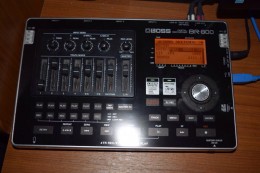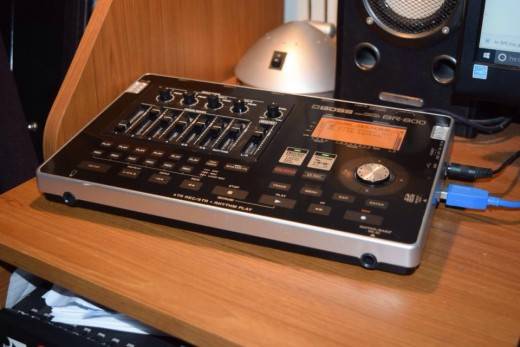How the BOSS BR-800 Digital Recorder became an invaluable part of my recording and practice setup.
My brief history of the stand-alone multi-track recorder
My first multi-track recorder, way back in the mid-90’s was a cassette-based Tascam 4-track Porta05 ministudio. Obviously cassette tape had it’s limitations, primarily the degradation of the tape itself after numerous takes. Then in 2000 along came the zip-disk based Boss BR-8; much more storage space, 24-bit digital quality, but still the necessity to switch disks, which were, at the time, becoming increasingly hard to find (a 100Mb mini disk held about 3 songs per disk). Nevertheless, with a decent external drum machine/keyboard I was able to put together tracks that I was fairly happy with. Now a BOSS convert, I purchased it’s successor, the compact-flash card based Boss BR-600 almost immediately, on it’s release in 2007. I fell in love, it was around half the size of the BR-8, with sleek rubber buttons that reminded me of my ZX Spectrum 48k back in the day, and a rather fetching champagne colour. It featured much larger, quieter and easier (and cheaper) to obtain storage, USB connectivity (to save songs to your PC), twin built-in condenser mics to quickly capture ideas, but most exciting of all, A BUILT IN DRUM MACHINE! BOSS really hit it out of the park with BR-600, and I spent a lot of my time happily recording with it, making the most out the great sounding COSM vocal and guitar amp models, in particular the GUITAR to BASS patch, which provided hours of fun.
Then I got distracted for a while with in the frustrating, latency plagued world of DAWs (Digital Audio Workstation) and dedicated USB audio interfaces. In the end I could never get a DAW working in my setup to satisfactory standard (see the link opposite for more details). I continued to record with the BR-600 until, in 2010, along came the follow up, and what I still use today, The BOSS BR-800 Digital Recorder.
First Impressions
As I’d come to expect from BOSS, the BOSS BR-800 appeared to build on it’s predecessor, the BR-600, the internal mics had been upgraded, in place of compact-flash we finally had SD-Card storage, the interface had been cleaned up, the rubber buttons replaced with much more modern touch-screen style layout and the screen enlarged. The new hardware was slightly bigger than the BR-600, but it was advertised to include many new features, most importantly of which was the ability to function as a USB audio interface for the first time in the BR series.

BOSS BR-800 Sketch Recording
Unlike the BR-600, we now have a dedicated button ‘Song Sketch’. One press and you’re into the recording mode of your choice. I set this up to record with the internal mics, and it’s become an invaluable alternative to using a dedicated PCM recorder. Even now the BR-800’s internal mics far surpass any mobile phone for recording band rehearsal’s / gigs etc, although for rough ideas I still tend to find my phone as it’s quicker and easier.
BOSS BR-800 As a practice tool
With it’s ability to function as a USB interface, the BOSS BR-800 has become a mainstay of my home practice setup, with no need for a guitar amp and effects pedals, I simply have the BR-800 and my PC connected to the same set of desktop monitors. I play back tracks from Youtube or Windows Media player for example, while the guitar sounds come from the excellent COSM models of the BR-800. While you’ll never get the response or dynamics of a valve amp at full tilt in this setup, for practicing at lower volumes the tones you can get out of the BR-800 are much better than just a compromise, in fact, you’ll have access to a wider range of tones than you would through one amp anyway. To make things even easier you also have the option of setting up your own user patches for clean, crunch, lead, acoustic, vocals, bass, etc and recalling them instantly.
BOSS’ rejection of the stand-alone multi-track format
As I delved deeper into the features of the BR-800, I got to the point of editing some drum tracks for my latest song, only to find, almost unbelievably, that the BR-800 DOESN’T INCLUDE DRUM TRACK EDITING! I took a step back, read the manual and went on-line only to have it confirmed, Not only that, but TRACK EDITING has also been greatly dumbed down. I must admit I was starting to feel ripped off by now, especially given the £399 price tag (at the time) and the fact that the above features were all included in the BR-600,
Sure, the mics were great, as was the song sketch, I liked the ‘EZ REC’ feature which gave you defaults, suggestions and made things easier to set up, but what I had here now was a £399 sketch pad, I couldn’t use the limited drums for complete songs (unlike the BR-600), in fact the lack of editing features made the song creation process a lot more clunky. To use the BR-800 effectively, I was forced into going back to the latency-ridden world of DAWs. The BR-800 represents, sadly, BOSS’ rejection of the stand-alone multi-track format.
The BOSS BR-800 as a USB audio interface
I researched DAWs again, settling on Ableton Live which seemed the most natural to work with. This would give me all the editing options I needed. For drums I went for ToonTrack EZ-Drummer, a million times better sounding and more flexible than any BOSS BR series recorder in any case. And then I integrated the BOSS BR-800 into the setup. A lightbulb moment! What I now had was essentially the best of all worlds. Editing, drums, general song project management and data storage were handled by the best tool for the job, a DAW on my PC. Whereas monitoring, including all the fantastic COSM vocal and guitar effects were handled, latency free, on the BR-800.
I was close before with DAWs, but had always used dedicated USB audio interfaces without vocal/guitar amp modelling, I’d messed about with DAW effects plugins but quickly found out that latency reared it’s ugly head the more effects you applied to the monitor send. No such problems with the BOSS BR-800.
The Competition
Zoom R8 – Similar spec to the BOSS BR-800, although it does include editing features that the BOSS lacks. Zoom’s amp modelling has always been impressive.
BOSS GT-001 – Billed as a desktop GT-100 Guitar Multi-Effects, but this tidy unit has a mic input enabling it to approach the BR-800’s functionality. Lacks internal mics and a dedicated vocal processor though.
TASCAM DP-32-SD – Tascam’s latest Portastudio Flagship has all the features you could ever want, but can it match the Zoom or BOSS amp sims ? Bargain price.
Conclusion
Way back in 2010, BOSS, in the BR-800 Digital Recorder, provided me with a tool, a solution. To this day I still use it for practice, capturing ideas and performances, but mostly as the ideal USB audio interface to monitor and record latency free effected vocal and guitar tracks for my music. The COSM vocal and amp models never fail to impress, both in their sounds and their flexibility. To end though, even though the era of the stand-alone ‘portastudio’ style recording interface is sadly resigned to history, in six years I’ve never felt the need to upgrade, the BOSS BR-800 just lets me get on with the job of making music,and I can’t give a better recommendation than that.
BOSS BR-800 Demos
Everything’s Alright. My own song Produced on my BOSS BR-800

Leave a Reply